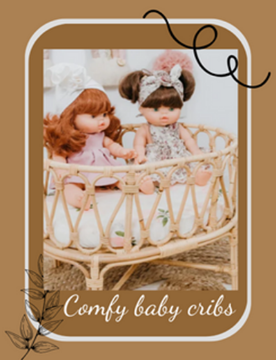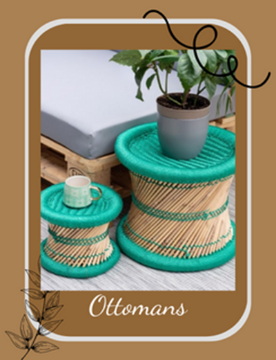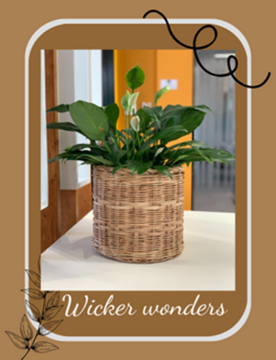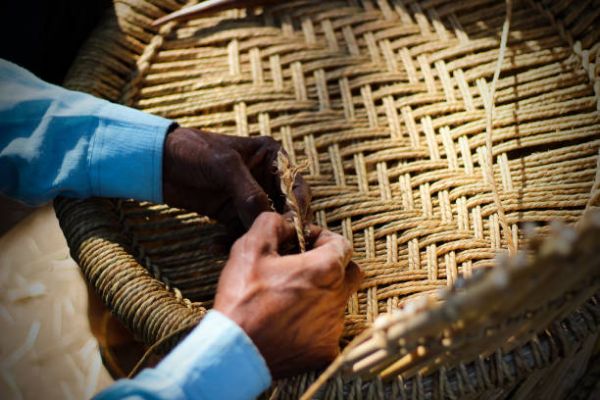In a world increasingly concerned with sustainability and environmental impact, bamboo furniture has emerged as a frontrunner in eco-conscious home décor. This remarkable grass—yes, bamboo is technically a grass, not a wood—has been transformed into everything from elegant dining sets to intricate decorative pieces for centuries. Its natural beauty, combined with exceptional durability and environmental credentials, has catapulted bamboo furniture into the spotlight of global interior design trends.
But not all bamboo furniture is created equal. The distinction between handmade and machine-made bamboo pieces represents a fascinating intersection of tradition and technology, artisanship and automation. This distinction impacts not only the aesthetic quality and durability of the furniture but also its environmental footprint and cultural significance.
Whether you're a seasoned interior designer, a conscious consumer, or simply someone looking to add a touch of natural elegance to your home, understanding the differences between handmade and machine-made bamboo furniture is essential for making informed choices. In this comprehensive guide, we'll explore these differences in depth, offering insights that will help you navigate the bamboo furniture market with confidence and clarity.
The Rich Heritage of Bamboo Craftsmanship
Ancient Roots, Modern Appeal
Bamboo craftsmanship has a history that spans millennia. In regions across Asia, particularly China, Japan, Indonesia, and the Philippines, artisans have been perfecting bamboo furniture-making techniques for generations. These traditional methods, passed down through families and communities, represent not just practical skills but cultural heritage.
Traditional bamboo crafting involves a deep understanding of the material's properties—its strength, flexibility, and natural patterns. Master artisans know precisely when to harvest bamboo, how to cure and treat it, and which techniques will best showcase its inherent beauty while ensuring structural integrity.
The Art of Handmade Bamboo Furniture
Handmade bamboo furniture creation is a meticulous process that begins with careful selection of raw materials. Artisans choose mature bamboo stalks, typically 3-5 years old, when the plant has reached optimal strength and density. The harvesting itself is done with precision, often during specific seasons and lunar phases that traditional knowledge suggests will yield the most durable material.
Once harvested, the bamboo undergoes natural curing methods to remove sugars and starches that might attract insects. This might involve soaking in water, smoking over a fire, or aging in shaded areas—processes that can take weeks or months but result in significantly more durable furniture.
The crafting itself involves techniques like:
- Splitting and shaping - Using specialized tools to divide bamboo into precise strips or sections
- Joinery - Creating interlocking connections without nails or screws
- Weaving - Forming intricate patterns with thin bamboo strips
- Bending - Applying heat and pressure to create curved elements
These techniques require not only skill but patience and an intimate knowledge of how bamboo behaves under different conditions. The result is furniture that bears the unmistakable mark of human hands—slight asymmetries, unique joinery details, and a character that can't be replicated by machines.
The Rise of Machine-Made Bamboo Furniture
Technology Meets Tradition
As global demand for sustainable furniture has increased, so too has the industrialization of bamboo furniture production. Modern manufacturing facilities now employ advanced machinery to process bamboo at scale, transforming raw stalks into furniture components with unprecedented speed and consistency.
The machine production process typically involves:
- Mechanized harvesting - Using equipment to quickly harvest large quantities of bamboo
- Industrial processing - Cutting, splitting, and shaping bamboo using automated equipment
- Standardized treatment - Chemical treatments for pest resistance and durability
- Engineered bamboo products - Creating bamboo plywood, laminated boards, and composite materials
- CNC machining - Computer-controlled cutting and carving for precise replication
- Assembly line construction - Systematic assembly using standardized components
These technological innovations have democratized access to bamboo furniture, making it more affordable and widely available than ever before. They've also allowed for product consistency and certain structural advantages that can be difficult to achieve with purely handmade methods.
The Evolution of Engineered Bamboo
One of the most significant developments in machine-made bamboo furniture is the creation of engineered bamboo materials. Unlike traditional bamboo furniture that uses the natural cylindrical stalks, engineered bamboo involves processing the material into flat boards, veneers, or composite products.
These include:
- Bamboo plywood - Multiple layers of bamboo strips pressed and glued together
- Strand-woven bamboo - Bamboo fibers compressed under high pressure with adhesives
- Bamboo composites - Bamboo combined with other materials for enhanced properties
These engineered products offer consistency in color, texture, and structural properties that natural bamboo stalks cannot match. They've expanded the design possibilities for bamboo furniture considerably, enabling modern, sleek forms that wouldn't be possible with traditional techniques alone.
Key Differences: Handmade vs. Machine-Made
Craftsmanship and Aesthetic Quality
The most immediately apparent difference between handmade and machine-made bamboo furniture lies in the details of craftsmanship:
Handmade Furniture Characteristics:
- Unique variations in color and texture
- Visible craftsmanship in joins and connections
- Organic, sometimes asymmetrical forms
- Traditional joinery techniques like pegging and binding
- Distinctive character marks that tell the story of its creation
Machine-Made Furniture Characteristics:
- Consistent coloration and finish
- Uniform dimensions and proportions
- Precise, repeatable design elements
- Modern fastening methods including hidden hardware
- Standardized appearance across production runs
Neither approach is inherently superior—they simply offer different aesthetic qualities that may appeal to different tastes and interior design approaches. Handmade pieces often bring warmth and character to spaces, while machine-made items can offer clean lines and contemporary styling.
Durability and Structural Integrity
When properly executed, both handmade and machine-made bamboo furniture can offer excellent durability, though they achieve it through different means:
Handmade Durability Factors:
- Master craftspeople understand bamboo's natural structural properties
- Traditional joinery often allows for flexibility and natural movement
- Repairs can be more intuitive and aligned with original construction
- Time-tested techniques that have proven their longevity over centuries
- Often built to be repaired and maintained over generations
Machine-Made Durability Factors:
- Engineered bamboo can offer consistent structural properties
- Modern adhesives and fasteners provide strong connections
- Quality control testing ensures structural standards
- Precision manufacturing can eliminate weak points
- Standardized parts make replacements more accessible
The durability equation isn't simply about handmade versus machine-made, but rather about quality of materials, design integrity, and execution—whether by skilled hands or precision machinery.
Environmental Impact
Bamboo is celebrated for its environmental benefits—it grows rapidly without fertilizers, regenerates after harvesting, and sequesters carbon. However, the environmental calculus changes somewhat when comparing traditional handcrafting with industrial production:
Environmental Aspects of Handmade Production:
- Often uses minimal electricity and fossil fuels
- Typically employs natural treatments and finishes
- Creates minimal waste as craftspeople use most parts of the bamboo
- Usually involves local harvesting and production, reducing transportation impact
- Supports sustainable harvesting practices based on generational knowledge
Environmental Aspects of Machine Production:
- Requires energy for machinery operation
- May use chemical treatments and synthetic adhesives
- Can generate more processing waste, though modern facilities often repurpose this
- Often involves global supply chains with larger carbon footprints
- Enables efficient use of material through engineered products
Both approaches can be environmentally responsible when executed with care and commitment to sustainability, but they represent different environmental trade-offs.
Cultural and Social Dimensions
Beyond practical considerations, the choice between handmade and machine-made bamboo furniture carries cultural significance:
Cultural Aspects of Handmade Furniture:
- Preserves traditional crafts and cultural knowledge
- Supports artisan communities and local economies
- Carries stories and cultural significance in its creation
- Represents a connection to heritage and historical techniques
- Often embodies regional design elements and motifs
Cultural Aspects of Machine-Made Furniture:
- Makes sustainable material choices accessible to wider markets
- Creates contemporary interpretations of traditional forms
- Develops new aesthetic possibilities through technology
- Generates employment in manufacturing and design sectors
- Allows for cultural fusion and global design influences
The social impact of your furniture choice extends beyond your home to the communities that produce these pieces—whether artisan villages practicing centuries-old techniques or modern manufacturing centers creating economic opportunities through scale.
The Fusion Approach: When Tradition Meets Technology
Best of Both Worlds
Increasingly, the most innovative bamboo furniture represents a thoughtful fusion of handcraft and technology. Forward-thinking manufacturers and designers are finding ways to combine the precision and efficiency of machines with the irreplaceable human touch:
- Using CNC machinery for precise cutting but hand-finishing joints
- Employing engineered bamboo for structural elements but natural bamboo for visible components
- Creating machine-made frames finished with handwoven elements
- Utilizing digital design tools to plan pieces that are then handcrafted
- Developing hybrid production methods that preserve traditional techniques while improving efficiency
These approaches acknowledge that the dichotomy between handmade and machine-made isn't always clear-cut. The most successful pieces often leverage technology where it adds value while preserving the human element where it matters most.
Case Studies in Innovation
Innovative Brand Examples:
- Philippines-based Bambusa Studio combines traditional Filipino weaving techniques with modern engineered bamboo frames, creating furniture that meets contemporary safety standards while preserving artisanal aesthetics.
- Indonesia's Modern Bamboo employs digital fabrication for precision cutting but relies on master craftspeople for assembly and finishing, resulting in furniture that combines structural innovation with handcrafted elegance.
- Vietnam's Bamboo Craft Village collectives have adopted semi-automated processing for bamboo preparation while maintaining entirely handcrafted assembly, allowing them to increase production without sacrificing quality.
These examples illustrate how the future of bamboo furniture likely lies not in choosing between tradition and technology, but in thoughtfully integrating both.
Making the Right Choice for Your Home
Factors to Consider
When deciding between handmade and machine-made bamboo furniture (or hybrid approaches), consider these key factors:
- Aesthetic preferences - Do you value the character and uniqueness of handmade pieces, or do you prefer the clean consistency of machine-made items?
- Budget considerations - Handcrafted pieces typically command higher prices due to the labor involved, while machine-made options offer more accessible price points.
- Use case - Is this a showpiece that will be admired more than used, or a high-traffic item that needs maximum durability?
- Environmental priorities - Are you more concerned with minimal processing and natural materials, or with efficient resource utilization?
- Cultural connections - Do you value the cultural heritage and traditional techniques embedded in handcrafted pieces?
- Design compatibility - Which approach better complements your existing décor and architectural style?
- Longevity expectations - Are you investing in pieces intended to become heirlooms, or seeking more temporary furnishings?
There's no universally correct answer—the right choice depends entirely on your specific situation, values, and needs.
Identifying Quality Regardless of Production Method
Whether handmade or machine-made, quality bamboo furniture shares certain characteristics:
Universal Quality Indicators:
- Smooth finishes without splinters or rough areas
- Tight, secure joints with minimal movement
- Even coloration (unless intentional variation is part of the design)
- Proper treatment against pests and humidity damage
- Clear finishes that showcase bamboo's natural beauty
- Structural stability without wobbling or flexing
- Attention to detail in less visible areas
Red Flags to Watch For:
- Excessive glue visible at joints
- Untreated bamboo that feels rough or raw
- Loose connections or wobbling elements
- Misaligned components or poor fit
- Artificial coloring that masks natural bamboo appearance
- Strong chemical smells indicating poor-quality treatments
These indicators apply regardless of production method—a well-executed machine-made piece is preferable to a poorly crafted handmade one, and vice versa.
The Rattan Connection: Bamboo's Crafting Cousin
Understanding the Bamboo-Rattan Relationship
When exploring bamboo furniture, you'll often encounter rattan as well. Though sometimes confused, these materials are distinct but complementary:
- Bamboo is a hollow grass with jointed stems (culms) that grows vertically and maintains its cylindrical shape when harvested.
- Rattan is a solid, vine-like palm that can be easily bent and manipulated when heated, making it ideal for curved furniture elements.
In traditional furniture-making throughout Southeast Asia, these materials are often used together—bamboo providing structural strength and rattan offering flexibility for curved elements and binding. This combination has created some of the most iconic furniture styles in global design.
Handcrafted vs. Machine-Made Rattan Elements
Like bamboo, rattan furniture exists on a spectrum from entirely handcrafted to machine-processed:
Traditional Rattan Crafting:
- Hand-splitting vines into precise widths
- Steam-bending around forms to create curves
- Hand-weaving intricate patterns for seats and backs
- Binding joints with thin rattan strips instead of nails or screws
Industrialized Rattan Production:
- Machine-splitting for consistent width strips
- Automated bending processes
- Pre-woven panels attached to frames
- Synthetic rattan alternatives for outdoor applications
The considerations for choosing between handmade and machine-made apply similarly to rattan elements in furniture.
Caring for Your Bamboo Furniture
Maintenance Essentials
Proper care can significantly extend the life of bamboo furniture, regardless of how it was produced:
Basic Care Guidelines:
- Dusting - Regular dusting with a soft cloth prevents buildup in crevices
- Cleaning - Wipe with a damp cloth and mild soap when needed, avoiding saturation
- Humidity management - Maintain moderate humidity levels to prevent cracking or warping
- Sunlight protection - Minimize direct sunlight exposure to prevent fading and drying
- Maintenance treatments - Apply food-safe mineral oil or bamboo-specific products annually
- Prompt attention to damage - Address any structural issues immediately before they worsen
Special Considerations by Type:
- Handmade pieces may require more attention to joints and bindings
- Machine-made items might need care at adhesive points and engineered surfaces
- Pieces with rattan elements need extra humidity awareness to prevent brittleness
With proper care, quality bamboo furniture—whether handmade or machine-made—can last for decades.
Restoration and Repair
Even well-maintained bamboo furniture may eventually need restoration:
Restoration Approaches:
- Simple repairs can often be DIY projects using bamboo-specific guidance
- More substantial restoration may require professional assistance
- Handmade pieces are generally more adaptable to traditional repair methods
- Machine-made items might need replacement parts from manufacturers
- Fusion pieces benefit from understanding which elements need which approach
The repairability of bamboo furniture represents another aspect of its sustainability—a well-made piece need not be discarded when damaged but can often be restored to full functionality.
The Global Market for Bamboo Furniture
Navigating International Options
The global nature of the bamboo furniture market offers both opportunities and challenges for consumers:
Major Production Regions:
- China - The world's largest bamboo producer and furniture exporter, offering everything from traditional handcrafts to cutting-edge engineered bamboo products
- Indonesia - Known for refined craftsmanship combining bamboo with rattan and other natural materials
- Vietnam - Emerging as a center for both traditional techniques and innovative designs
- Philippines - Recognized for distinctive weaving styles and organic forms
- India - Producing both traditional village handicrafts and contemporary designs
Each region brings distinctive traditions, techniques, and aesthetic approaches to bamboo furniture creation.
Ethical Considerations in Global Sourcing
As with any globally sourced product, ethical considerations should inform bamboo furniture purchases:
Ethical Sourcing Guidelines:
- Look for certifications like Forest Stewardship Council (FSC) for sustainably harvested bamboo
- Seek information about labor practices and fair compensation for artisans
- Consider the carbon footprint of shipping heavy furniture internationally
- Support companies that invest in the communities where they source and manufacture
- Research whether traditional knowledge is being appropriately valued and preserved
The most responsible manufacturers—whether of handmade or machine-made furniture—will be transparent about their sourcing, production methods, and community impact.
Design Trends: Bamboo Furniture in Contemporary Interiors
Current Styling Approaches
Bamboo furniture has transcended its traditional associations to become versatile elements in diverse interior styles:
Contemporary Applications:
- Minimalist spaces - Clean-lined bamboo pieces provide natural warmth without visual clutter
- Bohemian interiors - Handcrafted bamboo items add authentic character and artisanal appeal
- Scandinavian design - Light bamboo tones complement Nordic sensibilities while adding textural interest
- Luxury environments - High-end engineered bamboo creates sophisticated statement pieces
- Biophilic offices - Bamboo furniture connects commercial spaces to nature for wellbeing benefits
Designers increasingly appreciate bamboo's versatility, using both handcrafted and machined pieces to achieve specific aesthetic goals.
Mixing Bamboo with Other Materials
Some of the most exciting bamboo furniture designs incorporate complementary materials:
Popular Combinations:
- Bamboo with brass or black metal for contemporary contrast
- Bamboo frames with rattan weaving for textural diversity
- Engineered bamboo with leather upholstery for sophisticated seating
- Bamboo with stone or concrete for juxtaposition of natural elements
- Bamboo with recycled plastics for indoor-outdoor applications
These combinations often leverage the respective strengths of handcrafted and machine-made approaches, creating pieces that honor tradition while embracing innovation.
Frequently Asked Questions
1. Is bamboo furniture suitable for outdoor use?
Most bamboo furniture requires protection from direct weather exposure unless specifically treated for outdoor use. Some machine-made bamboo composites are engineered for outdoor applications, while traditional bamboo furniture generally performs best in covered outdoor spaces.
2. How can I tell if bamboo furniture is sustainably sourced?
Look for certifications like FSC, details about harvesting practices, and company transparency about sourcing. Both handmade and machine-made bamboo can be sustainably sourced—the key is finding manufacturers committed to responsible practices.
3. Will bamboo furniture match my existing décor?
Bamboo's natural versatility allows it to complement many interior styles. Machine-made bamboo offers more consistent colors and contemporary forms, while handmade pieces add character and organic elements to your space.
4. How do I clean bamboo furniture?
For both handmade and machine-made bamboo, gentle cleaning with a slightly damp cloth and mild soap is recommended. Avoid saturation and harsh chemicals that might damage the finish or structure.
Conclusion: Finding Your Perfect Bamboo Balance
The choice between handmade and machine-made bamboo furniture isn't about finding a universally "correct" answer, but rather about aligning your selection with your personal values, needs, and aesthetic sensibilities.
Handcrafted bamboo pieces offer unparalleled character, cultural connection, and the satisfaction of supporting traditional artisanship. They bring stories and heritage into your space, creating connections across generations and cultures. The slight variations and distinctive marks of handcraft add a human dimension that many find profoundly appealing in an increasingly mass-produced world.
Machine-made bamboo furniture, on the other hand, offers accessibility, consistency, and innovative forms that might not be possible through traditional methods alone. These pieces democratize access to sustainable materials and bring eco-conscious options to wider markets. The precision of machine production can create clean, contemporary designs that fit seamlessly into modern interiors.
Many of today's most exciting bamboo furniture represents thoughtful fusion—pieces that leverage technology where it adds value while preserving handcraft where it matters most. These hybrid approaches honor tradition while embracing innovation, creating furniture that's both forward-looking and respectful of heritage.
Whatever approach resonates with you, choosing bamboo furniture represents a step toward more sustainable living. This remarkable material—renewable, carbon-sequestering, and beautiful—offers an alternative to conventional furniture materials with significantly higher environmental costs. Whether handcrafted by artisans or precision-manufactured, bamboo furniture connects our homes to nature in ways that benefit both our living spaces and our planet.
Call to Action
Ready to bring the natural elegance and sustainability of bamboo into your home? Start by exploring both handcrafted and machine-made options to discover which approach resonates with your aesthetic and values. Visit specialized bamboo furniture retailers, connect with artisan cooperatives, or explore innovative manufacturers combining tradition with technology.
Consider starting with a statement piece—perhaps a handcrafted bamboo chair or a sleek, machine-made bamboo dining table—and experience firsthand the unique qualities this remarkable material brings to your space. As you live with and care for your bamboo furniture, you'll develop an appreciation for its distinctive character, durability, and environmental benefits.
Share your experiences with bamboo furniture in your home, and join the global conversation about sustainable materials in contemporary living. By choosing mindfully and caring properly for bamboo pieces, you're not just decorating your space—you're participating in a worldwide movement toward more conscious consumption and connection with both nature and craft traditions.







